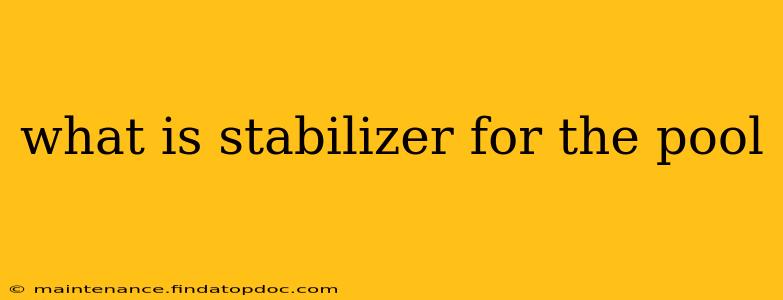What is a Pool Stabilizer? Understanding Cyanuric Acid and its Role in Pool Care
A pool stabilizer, more commonly known as cyanuric acid (CYA), is a crucial chemical for maintaining the effectiveness of your pool's chlorine. It acts as a protective shield, preventing the sun's ultraviolet (UV) rays from rapidly breaking down chlorine, extending its lifespan and improving its sanitizing power. Without a stabilizer, chlorine dissipates quickly, leaving your pool vulnerable to algae and bacteria growth, requiring significantly more chlorine to maintain proper sanitation.
Think of it like this: chlorine is the fighter, battling contaminants in your pool. Cyanuric acid is the bodyguard, protecting the fighter so it can stay in the fight longer and more effectively.
Why is a Pool Stabilizer Necessary?
Sunlight is the enemy of chlorine. UV rays break down chlorine molecules, rendering them ineffective in killing harmful microorganisms. Cyanuric acid creates a protective barrier around the chlorine molecules, slowing down this degradation process. This means you need to add less chlorine overall, saving you money and reducing the risk of chlorine imbalance issues.
What are the Benefits of Using a Pool Stabilizer?
- Extended Chlorine Lifespan: The most significant benefit is the extended effectiveness of your chlorine. This translates to less frequent chlorine additions and reduced chemical costs.
- Improved Sanitization: By protecting chlorine, CYA ensures your pool remains properly sanitized, reducing the risk of algae blooms and bacterial growth.
- Reduced Chlorine Demand: Less chlorine is needed overall, making pool maintenance more efficient and cost-effective.
- Clearer Water: Properly balanced water, thanks to effective chlorine, results in clearer, sparkling pool water.
How Much Stabilizer Should I Use?
The ideal CYA level for your pool is typically between 30 and 50 parts per million (ppm). Levels below 30 ppm offer insufficient protection for chlorine, while levels above 50 ppm can reduce chlorine effectiveness and potentially cause cloudy water. Always test your water regularly using a reliable test kit to monitor your CYA levels and make adjustments as needed.
What Happens if I Don't Use a Pool Stabilizer?
Without a stabilizer, your chlorine will degrade rapidly under sunlight. You’ll find yourself constantly adding chlorine to maintain proper sanitation, leading to higher chemical costs and a greater risk of chlorine imbalances. This can result in algae growth, cloudy water, and potential health concerns.
How Do I Add Pool Stabilizer?
Adding stabilizer is straightforward. Dissolve the granular stabilizer in a bucket of pool water before slowly pouring it into the pool, ideally while the pump is running. Always follow the instructions on the product label for specific dosage recommendations based on your pool's size and current CYA levels. Remember to test your water both before and after adding stabilizer to ensure you are adding the correct amount.
What are the signs of low stabilizer levels?
Low stabilizer levels often manifest as a rapid decrease in chlorine levels, even with regular additions. You might notice frequent algae blooms or consistently cloudy water despite regular cleaning and chlorine additions.
Can I add too much pool stabilizer?
Yes, adding too much stabilizer can actually hinder the effectiveness of your chlorine, leading to less effective sanitization, and causing cloudy water. Regular testing is crucial to maintaining optimal levels.
What are the different types of pool stabilizers?
While the primary active ingredient remains cyanuric acid, different brands may offer stabilizers in varying forms – typically granular or liquid. The choice usually comes down to personal preference and ease of use.
By understanding the importance of a pool stabilizer and maintaining the proper levels, you can ensure a clean, healthy, and enjoyable swimming experience throughout the season. Regular testing and proper maintenance are key to achieving and maintaining optimal pool water chemistry.
